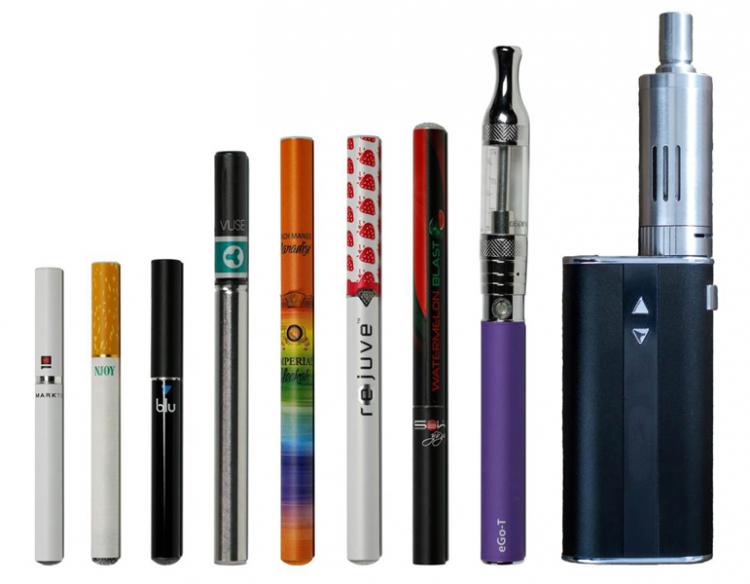In 2003, Chinese pharmacist Hon Lik created the first commercially successful electronic cigarette. Motivated by the death of his father, who was a heavy smoker and died of lung cancer, Lik had a simple concept: to separate nicotine delivery from the carcinogens in cigarettes. Instead of burning tobacco, his device vaporized a nicotine-containing liquid, thus creating smoke-like vapor that could be inhaled.
In 2006, e-cigarettes were introduced in Europe and the US. Uptake has been rapid among adults and youth alike. According to the Centers for Disease Control and Prevention, in 2016, more than 2 million US middle and high school students had used e-cigarettes in a 30-day period, and 3.2 percent of US adults (approximately 10.4 million) were current users. Because e-cigarettes don’t burn tobacco, but simply heat a liquid until it vaporizes, users refer to “vaping” rather than “smoking,” and there is a widespread perception that e-cigarettes are less damaging to users’ health than conventional cigarettes. But are they right?
Early on, in the absence of any scientific studies of e-cigarettes’ potential harm, some scientists and advocates adhered to the “precautionary principle” — that is, “until we have more science, we don’t know what to do about this and we ought to be very careful because it’s got nicotine in it and we don’t know what harm the aerosol has,” says clinical health psychologist David Abrams of the New York University College of Global Public Health. That, he believes, is no longer the case today.

Since electronic cigarettes were first introduced in the United States and Europe in 2006, a wide variety have come to market. Many questions remain about their long-term health risks.
CREDIT: © 2017 CALIFORNIA DEPARTMENT OF PUBLIC HEALTH
The body of research on the safety and public health impacts of e-cigarettes has grown substantially in recent years, but important questions have yet to be answered. In fact, two very different interpretations have emerged among the scientists who study e-cigarette use.
On the one hand, some researchers argue that e-cigarettes are an obvious win for public health. “The e-cigarette is just the beginning of a proof of principle of what I regard as a potential disruptive technology that literally could make cigarettes obsolete and save lives,” by helping smokers quit, says Abrams.
On the other hand, studies suggest that e-cigarettes may be depressing quitting rates and creating a gateway to traditional cigarettes, especially among young people. For these reasons, “we would be way better off if they didn’t exist,” says tobacco control scientist Stanton Glantz of the University of California, San Francisco.
The controversy is based on three principal issues: whether e-cigarettes are safe; whether they help or undermine attempts to quit; and whether they expand the nicotine market by attracting youth who otherwise might not ever light up, thus functioning as a gateway to traditional cigarettes.
Fewer carcinogens doesn’t mean safe
Because e-cigarettes don’t deliver the tar and carcinogens that traditional cigarettes do, users largely believe that they are a much safer nicotine delivery product. Indeed, studies show that e-cigarettes release fewer harmful chemicals, such as hydrogen cyanide and carbon monoxide (two of the more than 7,000 chemicals in tobacco smoke). So they may be a more effective way to reduce tobacco use — and prevent lung cancer — than current quitting aids.
“The scientific evidence supports that they can be a reduced-harm product that could save millions of lives more rapidly than the current status quo,” says Abrams.
But cancer is not the only disease to worry about. Other studies show that the aerosols produced by e-cigarettes contain ultrafine particles that cause cardiovascular disease by interfering with the normal functioning of blood vessels, Glantz says. Glantz’s recent work shows that daily use of e-cigarettes nearly doubles the risk of heart attacks (daily use of conventional cigarettes nearly triples the odds). The ultrafine particles also cause inflammation in the lungs, leading to increased risk of respiratory infections and severe asthma, he says.
E-cigarettes are “actually looking like they’re worse than cigarettes in terms of effects on the lungs and it’s hard to believe anything could be worse than a cigarette,” says Glantz.
Overall, e-cigarettes may well be less harmful than cigarettes, as many e-cigarette makers claim, but there are no long-term studies of that issue. That’s because e-cigarettes haven’t been on the market long enough for that kind of research, explains Erika Westling, a public health researcher at Oregon Research Institute.
Still, many argue that e-cigarettes offer a reasonable pathway to that ultimate public health goal: getting people to quit smoking. But that, too, proves to be a contentious point.
E-cigarettes don’t necessarily snuff out smoking
One of the appeals of e-cigarettes has been their potential use as quitting aids, much like nicotine patches and lozenges that are approved by the US Food and Drug Administration for smoking cessation.
In a pilot trial published in December 2017 in Cancer Epidemiology, Biomarkers & Prevention, 68 adult smokers were randomized to receive e-cigarettes or nothing. Researchers found that those who had the option to use e-cigarettes made more attempts to quit and decreased their conventional smoking relative to the control group. At the end of the four-month trial, 27.3 percent of control participants had made an attempt to quit compared with 40 percent of those receiving low-dose e-cigarettes and 47.6 percent of those receiving high-dose e-cigarettes. By the end of the trial, 4.6 percent of controls, compared to 9.5 percent of those receiving the high-dose e-cigarettes, had gone at least seven days without a smoke.
E-cigarettes could be useful in helping adults quit smoking, concludes Matthew Carpenter, an addiction scientist at the Medical University of South Carolina who led the trial. But, he notes, the study was small, and he’s now recruiting participants for a larger one to see if the findings can be replicated.
Population studies show a slightly different picture. In a meta-analysis of 20 studies, Glantz and his UCSF colleague Sara Kalkhoran found that the odds of quitting cigarettes were 28 percent lower for smokers who used e-cigarettes than for those who did not. In the real world, many e-cigarette users take them up with an intention to quit tobacco. But others use them without such an aim, perhaps to get a nicotine fix in areas with smoking restrictions. “Importantly, most adults who use e-cigarettes continue to smoke conventional cigarettes (referred to as dual users),” Glantz and David Bareham of Lincolnshire Community Health Services in the UK wrote in the 2018 Annual Review of Public Health. “In 2014 in the United States, 93 percent of e-cigarette users continued to smoke cigarettes, 83 percent in France, and 60 percent in the United Kingdom.”
In a study of young adults, Westling found that a large portion of smokers who add e-cigarettes and become dual users aren’t more likely to quit. Because e-cigarettes are convenient and relatively discreet, users might actually increase their habit, worsening their addiction, Westling says.
Smokers who have a plan for tapering their nicotine levels can use e-cigarettes as a cessation tool, “but if they don’t have that plan in place and haven’t really thought it through, adding e-cigarettes can really just increase their level of nicotine dependence, unfortunately,” Westling says. “You can't really just add e-cigarettes in and think that that's going to take care of the problem.”
From vaping to cigarettes
Critics of e-cigarette manufacturers — many of which are also tobacco companies — have complained that e-cigarettes are aggressively marketed to youth. The packaging can be sleek and attractive, and e-liquids come in thousands of flavors, including bubble gum and cinnamon red hots. Teens are definitely experimenting with the devices. Often, says Westling, adolescents don't even think that e-cigarettes have nicotine or are risky. “A lot of these kids think that it’s just flavored water, so no big deal.”

One area of agreement among public health researchers is that e-cigarettes are addictive and should not be used by youth.
© 2017 CALIFORNIA DEPARTMENT OF PUBLIC HEALTH
But once they become addicted to nicotine, it’s notoriously difficult to stop. Public health researcher Jessica Barrington-Trimis and her colleagues have shown that adolescents who vape are more likely to start smoking cigarettes too. The University of Southern California researchers found that 40.4 percent of high schoolers who used e-cigarettes took up cigarettes. Only 10.5 percent of high schoolers who never used e-cigarettes did so.
Even adolescents who had no intention of smoking still had a higher chance of becoming smokers if they vaped. This suggests that “e-cigarette use was not simply a marker for individuals who would have gone on to smoke regardless of e-cigarette use,” Barrington-Trimis and her coauthors wrote in 2016 in Pediatrics.
“It really indicates that some kids who probably wouldn't have used cigarettes are in fact using cigarettes,” Westling says.
“If we’re getting kids to initiate nicotine dependence and converting them to regular smokers, we’ve done a very, very unfortunate thing,” says Carpenter, who adds that it’s difficult to nail down whether e-cigarette use actually caused the development of a smoking habit.
Abrams contends that adolescents with risk-taking behavior are most likely to try a variety of things, including e-cigarettes, traditional cigarettes, marijuana and alcohol; when controlling for these other factors, the gateway effect of e-cigarettes disappears, he argues. “I don’t think nicotine should be scapegoated...because we can’t stop kids from completely using or trying any of these drugs,” Abrams says.
The key, Abrams adds, is to keep an eye on youth cigarette use. The Monitoring the Future study, which has been going on for over 40 years, and the National Youth Tobacco Survey both show that youth cigarette use has long been declining. That’s good news, and suggests that if there is a gateway effect from vaping, it is not affecting huge numbers of youth. Still, he recognizes it as a valid concern and believes that precautions should be put in place to prevent young people from getting access to e-cigarettes.
The bottom line
Until scientists have more data, collected over more time, it’s likely that the opposing views on the public health implications of e-cigarettes will continue.

The flavors and packaging of some of the “e-liquids” used in vaping appear expressly targeted at youth. Critics say such marketing encourages teen use of an addictive product and shouldn't be allowed.
CREDIT: U.S. FDA
Not surprisingly, opinions also differ on how e-cigarettes should be regulated for adult use.
“I think they should be taxed like cigarettes,” Glantz says. “They are another form of tobacco product which is supporting the tobacco epidemic.” Such taxes would deter e-cigarette use just like high taxes on traditional cigarettes. He also argues that public education campaigns should warn about dual use and the gateway effect.
Abrams advocates for regulation in proportion to harm. Traditional cigarettes, being the most harmful, should be the most highly taxed, while purportedly less harmful e-cigarettes should be taxed but at a lower rate, to create an incentive for smokers to switch. He maintains that e-cigarettes are much less harmful than traditional cigarettes and public education campaigns should emphasize that.
Most public health researchers do concur on a few points. E-cigarettes shouldn’t be allowed in places where smoking isn’t allowed, for instance, nor sold to young people. “I think we all agree that no nicotine-containing products should be sold or marketed directly to kids under the age 21. There’s no reason on Earth to have either alcohol or marijuana or nicotine accessible to minors,” Abrams says.

Traditional cigarettes were long marketed to youth as a habit of a rebel; successful anti-tobacco campaigns have appealed to youth rebellion as well through criticism of Big Tobacco. This collage of vaping stickers fits well in that tradition, mimicking skateboard-culture style.
CREDIT: VAPES.COM
There are already regulations to prevent minors from purchasing e-cigarettes. Since 2016, the FDA has regulated e-cigarettes by prohibiting their sale to people under 18. Beginning in August, makers will not be allowed to sell or distribute e-cigarettes without a health warning statement on the package. Advertisements also will have to include a health warning, though it is unclear what the warning will say. In April 2018, the FDA also announced an undercover operation to target e-cigarette retailers selling the products to minors.
Marketing of e-cigarettes remains an area rife with conflicting opinions, and it's sure to attract more controversy. According to the CDC, in 2014, more than 18 million (7 out of 10) US middle and high school youth were exposed to e-cigarette ads online or in retail stores. Advertising spending on e-cigarettes increased from $6.4 million in 2011 to $115 million in 2014. Tobacco companies have resisted the FDA’s attempts to regulate marketing to minors, and the burden of proof is on the FDA and public health researchers to demonstrate that the marketing is harmful to young people.
To change that, Westling says, researchers will have to come up with the data.




